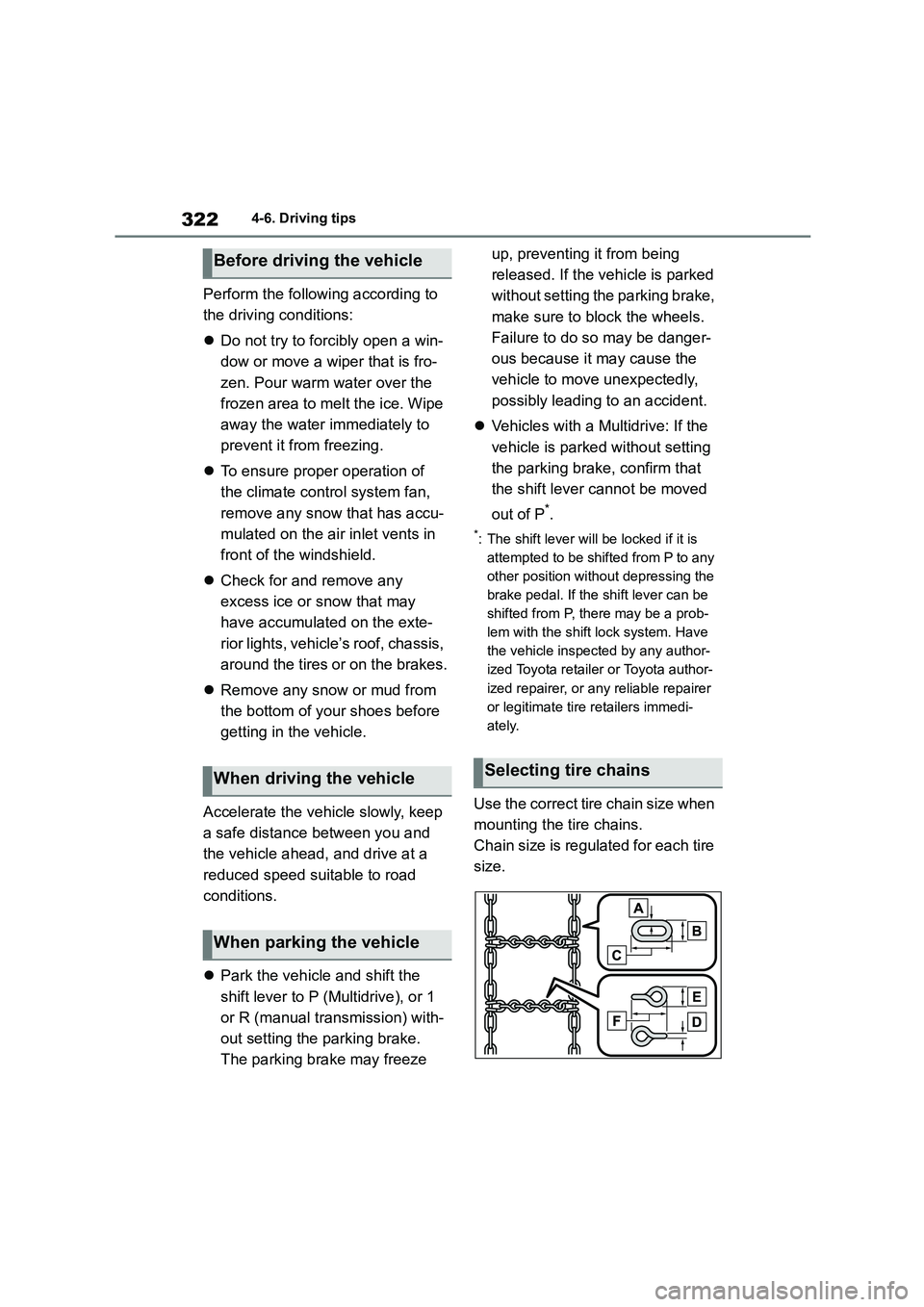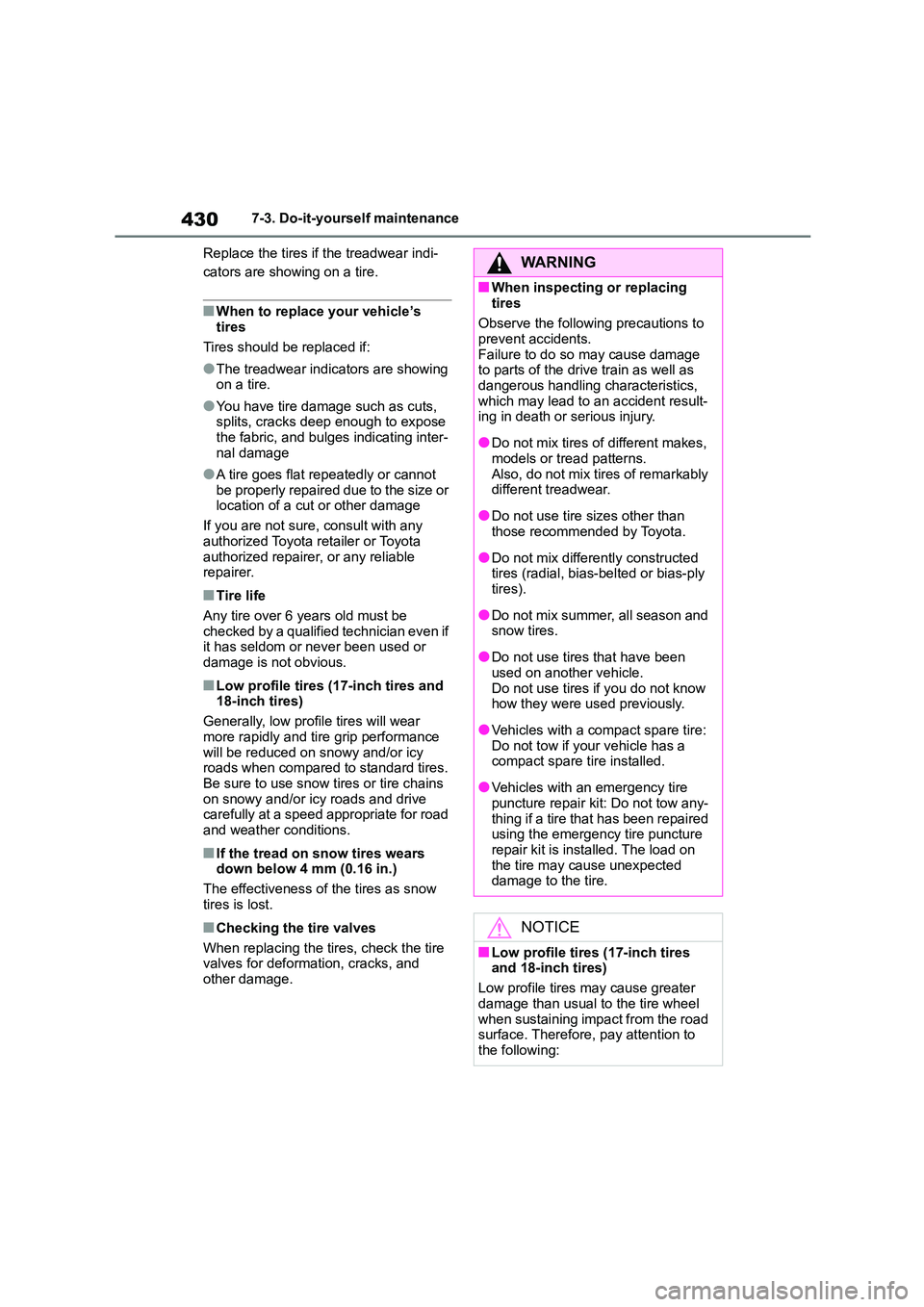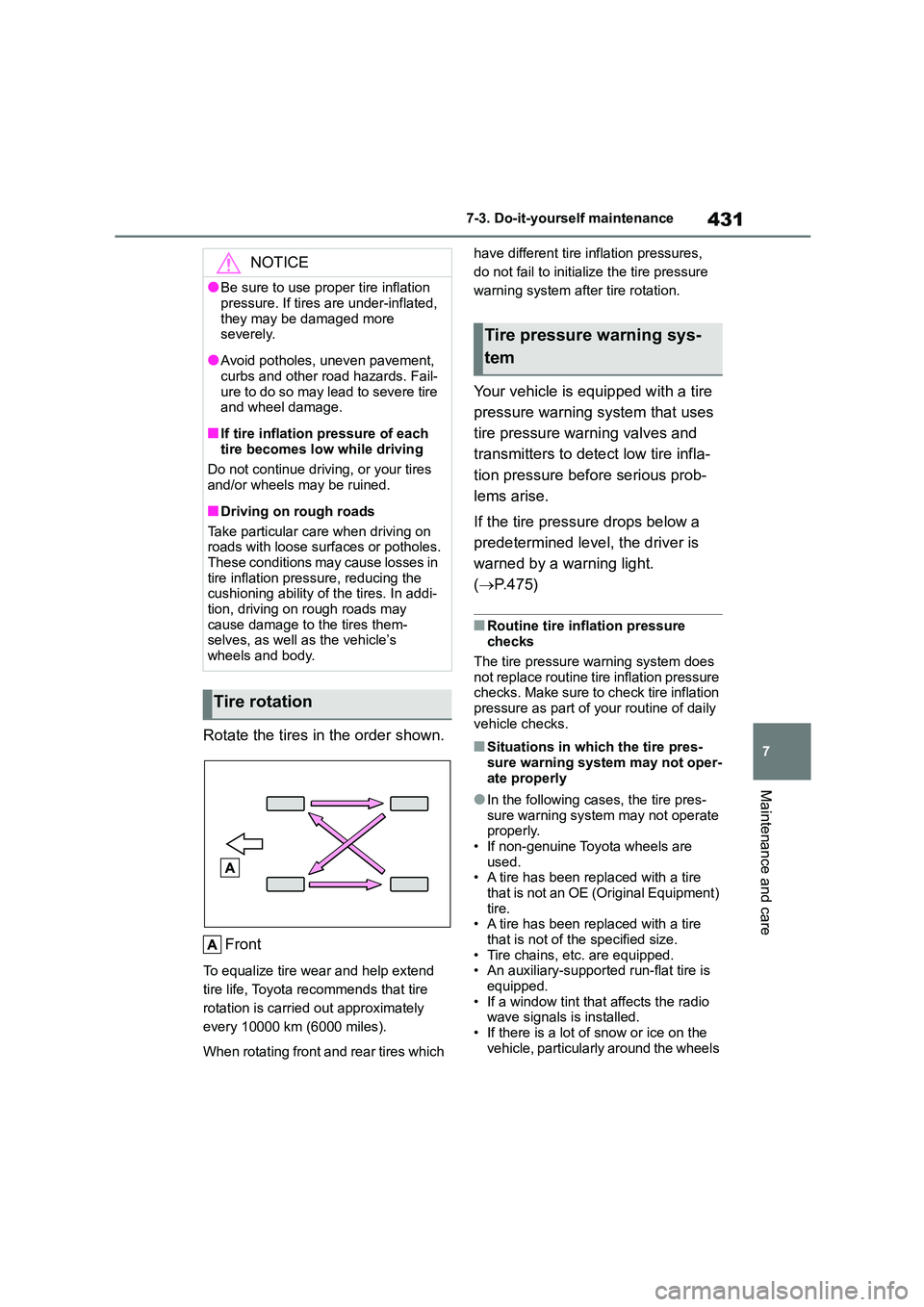2022 TOYOTA COROLLA snow chains
[x] Cancel search: snow chainsPage 324 of 678

3224-6. Driving tips
Perform the following according to
the driving conditions:
Do not try to forcibly open a win-
dow or move a wiper that is fro-
zen. Pour warm water over the
frozen area to melt the ice. Wipe
away the water immediately to
prevent it from freezing.
To ensure proper operation of
the climate control system fan,
remove any snow that has accu-
mulated on the air inlet vents in
front of the windshield.
Check for and remove any
excess ice or snow that may
have accumulated on the exte-
rior lights, vehicle’s roof, chassis,
around the tires or on the brakes.
Remove any snow or mud from
the bottom of your shoes before
getting in the vehicle.
Accelerate the vehicle slowly, keep
a safe distance between you and
the vehicle ahead, and drive at a
reduced speed suitable to road
conditions.
Park the vehicle and shift the
shift lever to P (Multidrive), or 1
or R (manual transmission) with-
out setting the parking brake.
The parking brake may freeze
up, preventing it from being
released. If the vehicle is parked
without setting the parking brake,
make sure to block the wheels.
Failure to do so may be danger-
ous because it may cause the
vehicle to move unexpectedly,
possibly leading to an accident.
Vehicles with a Multidrive: If the
vehicle is parked without setting
the parking brake, confirm that
the shift lever cannot be moved
out of P*.
*: The shift lever will be locked if it is
attempted to be shifted from P to any
other position without depressing the
brake pedal. If the shift lever can be
shifted from P, there may be a prob-
lem with the shift lock system. Have
the vehicle inspected by any author-
ized Toyota retailer or Toyota author-
ized repairer, or any reliable repairer
or legitimate tire retailers immedi-
ately.
Use the correct tire chain size when
mounting the tire chains.
Chain size is regulated for each tire
size.
Before driving the vehicle
When driving the vehicle
When parking the vehicle
Selecting tire chains
Page 432 of 678

4307-3. Do-it-yourself maintenance
Replace the tires if the treadwear indi-
cators are showing on a tire.
■When to replace your vehicle’s
tires
Tires should be replaced if:
●The treadwear indicators are showing on a tire.
●You have tire damage such as cuts, splits, cracks deep enough to expose
the fabric, and bulges indicating inter-
nal damage
●A tire goes flat repeatedly or cannot
be properly repaired due to the size or location of a cut or other damage
If you are not sure, consult with any
authorized Toyota retailer or Toyota authorized repairer, or any reliable
repairer.
■Tire life
Any tire over 6 years old must be checked by a qualified technician even if
it has seldom or never been used or
damage is not obvious.
■Low profile tires (17-inch tires and 18-inch tires)
Generally, low profile tires will wear
more rapidly and tire grip performance will be reduced on snowy and/or icy
roads when compared to standard tires.
Be sure to use snow tires or tire chains
on snowy and/or icy roads and drive carefully at a speed appropriate for road
and weather conditions.
■If the tread on snow tires wears
down below 4 mm (0.16 in.)
The effectiveness of the tires as snow
tires is lost.
■Checking the tire valves
When replacing the tires, check the tire valves for deformat ion, cracks, and
other damage.
WA R N I N G
■When inspecting or replacing
tires
Observe the following precautions to prevent accidents.
Failure to do so may cause damage
to parts of the drive train as well as dangerous handling characteristics,
which may lead to an accident result-
ing in death or serious injury.
●Do not mix tires of different makes,
models or tread patterns.
Also, do not mix tires of remarkably different treadwear.
●Do not use tire sizes other than those recommended by Toyota.
●Do not mix differently constructed tires (radial, bias-belted or bias-ply
tires).
●Do not mix summer, all season and
snow tires.
●Do not use tires that have been
used on another vehicle.
Do not use tires if you do not know how they were used previously.
●Vehicles with a compact spare tire: Do not tow if your vehicle has a
compact spare tire installed.
●Vehicles with an emergency tire
puncture repair kit: Do not tow any-
thing if a tire that has been repaired using the emergency tire puncture
repair kit is installed. The load on
the tire may cause unexpected damage to the tire.
NOTICE
■Low profile tires (17-inch tires
and 18-inch tires)
Low profile tires may cause greater
damage than usual to the tire wheel
when sustaining impact from the road surface. Therefore, pay attention to
the following:
Page 433 of 678

431
7
7-3. Do-it-yourself maintenance
Maintenance and care
Rotate the tires in the order shown.
Front
To equalize tire wear and help extend
tire life, Toyota recommends that tire
rotation is carried out approximately
every 10000 km (6000 miles).
When rotating front and rear tires which
have different tire inflation pressures,
do not fail to initialize the tire pressure
warning system afte r tire rotation.
Your vehicle is equipped with a tire
pressure warning system that uses
tire pressure warning valves and
transmitters to detect low tire infla-
tion pressure before serious prob-
lems arise.
If the tire pressure drops below a
predetermined level, the driver is
warned by a warning light.
( P. 4 7 5 )
■Routine tire inflation pressure
checks
The tire pressure warning system does
not replace routine tire inflation pressure
checks. Make sure to check tire inflation pressure as part of your routine of daily
vehicle checks.
■Situations in which the tire pres-
sure warning system may not oper-
ate properly
●In the following cases, the tire pres-
sure warning system may not operate properly.
• If non-genuine Toyota wheels are
used. • A tire has been replaced with a tire
that is not an OE (Original Equipment)
tire. • A tire has been replaced with a tire
that is not of the specified size.
• Tire chains, etc. are equipped. • An auxiliary-supported run-flat tire is
equipped.
• If a window tint that affects the radio wave signals is installed.
• If there is a lot of snow or ice on the
vehicle, particularly around the wheels
NOTICE
●Be sure to use proper tire inflation
pressure. If tires are under-inflated,
they may be damaged more severely.
●Avoid potholes, uneven pavement, curbs and other road hazards. Fail-
ure to do so may lead to severe tire
and wheel damage.
■If tire inflation pressure of each
tire becomes low while driving
Do not continue driving, or your tires and/or wheels may be ruined.
■Driving on rough roads
Take particular care when driving on
roads with loose surfaces or potholes.
These conditions may cause losses in tire inflation pressure, reducing the
cushioning ability of the tires. In addi-
tion, driving on rough roads may cause damage to the tires them-
selves, as well as the vehicle’s
wheels and body.
Tire rotation
Tire pressure warning sys-
tem
Page 508 of 678

5068-2. Steps to take in an emergency
●Make sure to check the tire inflation
pressure of the compact spare tire. ( P.533)
■When the compact spare tire is
equipped
The vehicle becomes lower when driv- ing with the compact spare tire com-
pared to when driving with standard
tires.
■After completing the tire change
The tire pressure warning system must
be reset. ( P.442)
■When using the spare tire
As the spare tire is not equipped with a tire pressure warning valve and trans-
mitter, low inflation pressure of the spare
tire will not be indicated by the tire pres- sure warning system. Also, if you
replace the spare tire after the tire pres-
sure warning light comes on, the light remains on.
■If you have a flat front tire on a road
covered with snow or ice
Install the compact spare tire on one of the rear wheels of the vehicle. Perform
the following steps and fit tire chains to
the front tires:
1 Replace a rear tire with the compact spare tire.
2 Replace the flat front tire with the tire
removed from the rear of the vehicle.
3 Fit tire chains to the front tires.
Page 564 of 678

562Alphabetical Index
Engine immobilize r system .......... 74
Tire inflation pressure .................. 444
Maintenance data ...................... 533
Warning light .............................. 475
Tire pressure warning system
Function ..................................... 431
Initializing ................................... 442
Installing tire pressure warning
valves and transmitters ............ 441
Registering ID codes.................. 443
Warning light .............................. 475
Tires
Chains ........................................ 322
Checking .................................... 429
Emergency tire puncture repair kit
................................................. 482
If you have a flat tire........... 482, 498
Inflation pressure ....................... 444
Replacing ................................... 498
Rotating tires .............................. 431
Size ............................................ 533
Snow tires .................................. 321
Spare tire ................................... 498
Tire pressure wa rning system .... 431
Warning light .............................. 475
Tools ...................................... 484, 499
Top tether anchorages ................... 58
To w i n g
Emergency towing ..................... 465
Towing capacity.......................... 524
Towing eyelet ............................. 467
Trailer towing ..................... 153, 158
Toyota parking assist-sensor
Function ..................................... 263
Warning message ...................... 266
Toyota Safety Sense
AHB (Automatic High Beam) ..... 181
Dynamic radar cruise control ..... 238
Dynamic radar cruise control with
full-speed range ....................... 227
LDA (Lane Departure Alert with
steering control) ....................... 219
LTA (Lane Tracing Assist) .......... 209
PCS (Pre-Collision System) ....... 202
RSA (Road Sign Assist) ............. 254
Traction Control (TRC) ................. 316
Trailer towing ........................153, 158
Transmission
Driving mode select switch.........314
Gear Shift Indicator .................... 170
If the shift lever cannot be shifted
from P ......................................166
M mode ..............................167, 168
Manual transmission ..................169
Multidrive .................................... 165
TRC (Traction Control) ................. 316
Trip meters ................................ 86, 91
Trunk .............................................. 118
Smart entry & start system ......... 119
Trunk grip ...................................120
Trunk light...................................120
Trunk opener .............................. 119
Wireless remote control ............. 119
Trunk features ............................... 399
Trunk light .....................................120
Wattage ......................................535
Turn signal lights
Replacing light bulbs ..................456
Turn signal lever ......................... 171
Wattage ......................................535
U
USB charging port ........................401
USB port ........................................328
V
Vanity lights...................................406
Wattage ......................................535
Vanity mirrors................................406
Vehicle data recording ..................... 7
Vehicle identification number ...... 524
Vehicle information display ........... 97
Vehicle Stability Control (VSC) ....316
Vehicle Stability Control+ (VSC+) 316
VSC (Vehicle Stability Control) ....316
VSC+ (Vehicle Stability Control+) 316